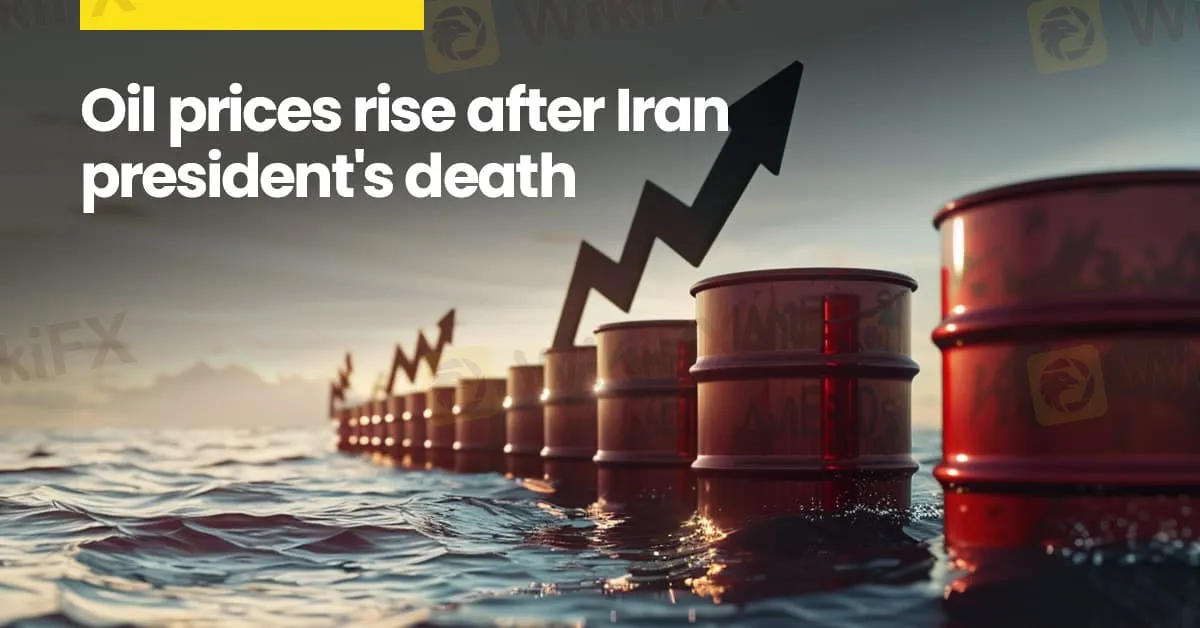简体中文
繁體中文
English
Pусский
日本語
ภาษาไทย
Tiếng Việt
Bahasa Indonesia
Español
हिन्दी
Filippiiniläinen
Français
Deutsch
Português
Türkçe
한국어
العربية
Oil Prices rise after Iran president’s death
Abstract:According to the report, oil prices surged during early Asian trading on Monday, building upon last week's upward momentum. This uptick was driven by multiple factors, including the unfolding search for Iran's president after a helicopter crash in the oil-rich nation and the United States' decision to purchase crude to bolster its national reserves.

According to the report, oil prices surged during early Asian trading on Monday, building upon last week's upward momentum. This uptick was driven by multiple factors, including the unfolding search for Iran's president after a helicopter crash in the oil-rich nation and the United States' decision to purchase crude to bolster its national reserves.
As of 0049 GMT, Brent crude had risen by 26 cents, representing a 0.3 percent increase, reaching $84.24 per barrel. Similarly, U.S. West Texas Intermediate (WTI) crude saw a gain of 15 cents, or 0.2 percent, reaching $80.21 per barrel.
The previous week concluded with Brent crude experiencing a 1 percent uptick, marking its first weekly gain in three weeks. Meanwhile, WTI crude climbed by 2 percent, buoyed by positive economic indicators from both the U.S. and China, the world's largest consumers of oil.
The recent surge in crude oil prices has been underpinned by several factors. Firstly, a helicopter carrying Iranian President Ebrahim Raisi crashed on Sunday, raising concerns about the safety of high-profile figures in the region. Despite this development, the impact on oil prices remained relatively subdued. Additionally, market focus is shifting towards the upcoming meeting of the Organization of the Petroleum Exporting Countries (OPEC) and its allies on June 1, where discussions on output policy are expected to provide clarity to the market.
Warren Patterson, head of commodities strategy at ING, highlighted the current state of the oil market, stating, “The oil market remains largely rangebound, and without any fresh catalyst, we will likely have to wait for clarity around OPEC output policy to break out of this range. The market also appears increasingly numb to developments on the geopolitical front, likely due to the large amount of spare capacity OPEC is sitting on,” as quoted by Reuters.
Meanwhile, seizing the opportunity presented by the recent dip in oil prices, the U.S. government announced its purchase of 3.3 million barrels of oil at $79.38 per barrel to replenish its Strategic Petroleum Reserve, following a significant drawdown from the reserve in 2022.
Last week, market sentiment received a boost from indications of easing inflation in the U.S., which raised expectations of potential interest rate cuts. Such cuts could potentially weaken the dollar, thereby making oil more affordable for holders of other currencies.

Disclaimer:
The views in this article only represent the author's personal views, and do not constitute investment advice on this platform. This platform does not guarantee the accuracy, completeness and timeliness of the information in the article, and will not be liable for any loss caused by the use of or reliance on the information in the article.
Read more

RM5.9M Lost to "Davidson Kempner Capital Management" Facebook Scam
A private contractor in Malaysia faced a devastating loss of over RM5.9 million after falling victim to a fraudulent investment scheme promoted on Facebook. Tempted by the scheme’s impressive claims and credentials, the victim began investing in September 2024. The investment process required him to download an application called A-Trade, which was readily available on the Apple Store.

Is There Still Opportunity as Gold Reaches 4-Week High?
Gold Continues to Rise, can the Bulls Keep Going? Recently, gold prices have been on the rise, especially following the release of the non-farm payrolls data, as demand for gold as a safe-haven asset continues to increase.

Breaking News! Federal Reserve Slows Down Interest Rate Cuts
The latest Federal Reserve meeting minutes show that Fed officials are generally concerned about the upward risks to inflation, suggesting that future rate cuts may slow down.

Big News! UK 30-Year Bond Yields Soar to 25-Year High!
Following the successful auction of 30-year government bonds by the UK, the yield on 30-year bonds surged, reaching its highest level in 25 years. This increase reflects growing concerns in the market over the government's fiscal policies and large-scale debt issuance.
WikiFX Broker
Latest News
High-Potential Investments: Top 10 Stocks to Watch in 2025
US Dollar Insights: Key FX Trends You Need to Know
Why Is Nvidia Making Headlines Everywhere Today?
Discover How Your Trading Personality Shapes Success
FINRA Charges UBS $1.1 Million for a Decade of False Trade Confirmations
Bitcoin in 2025: The Opportunities and Challenges Ahead
BI Apprehends Japanese Scam Leader in Manila
Big News! UK 30-Year Bond Yields Soar to 25-Year High!
SQUARED FINANCIAL: Your Friend or Foe?
Join the Event & Level Up Your Forex Journey
Currency Calculator






